Feedback has permeated every aspect of the modern retail experience, which is no surprise since customers want to be heard.
Feedback is important; in fact, 91% of people think businesses should fuel innovation by listening to customers, compared to only 31% who think they should hire a team of experts. There’s no escaping it, either. Due to the review culture in which we live, it has become easier and easier for customers to go on websites such as Yelp or Google Reviews, or on social media, to broadcast their thoughts.
Feedback has permeated every aspect of the modern retail experience, which is no surprise since customers want to be heard. So, it makes sense for home retailers to get as much tangible feedback as possible in order to act on it. But how? What’s the best way to go about gathering those insights? And what can they do to stand out from their competitors? Technology holds the key.
Using technology to listen
Creating a customer journey where, at the end, consumers are likely to leave feedback on their experience at that time means they are equally likely to offer insights that can be used to drive deeper engagement and encourage repeat business. As customer feedback can make the difference between business success or failure, it is important to provide the right channels to uncover it, as well as acting upon it in a constructive way.
For those who have rolled out the latest 3D planning solutions, such as HomeByMe for Home Retailers, this technology can be used to open up new routes for accessing the most useful insights possible. 3D planning technology introduces a trio of advantages to the feedback process: first through the analysis of data, second through the use of surveys, and third via social media engagement.
#1: Feedback through data
Data is an invaluable resource to gain quantitative feedback from customers. While customers are designing their homes in a 3D planning solution, data can be collected on a number of things including what products are popular and unpopular, stylistic trends, and design sets around which they are basing their home.
This feedback can then enhance the customer journey. Home retailers can use their findings to create product catalogs specific to each customer, design sets that are geared to individual preferences, and predict future trends to gain an edge on their competitors. In turn, this allows retailers to increase efficiencies, up-sell, and grow revenue by generating more sales, all while enhancing the customer experience.
By using platform data, and feedback gained from it, retailers can also promote products to the customer in different ways. First, by knowing the preferences of the customer, they can promote products which they are more likely to buy. Second, products can also be promoted through discounts where a home retailer gets something in return. For example, a home retailer could offer 10% off a product if a customer fills in a survey. This enhances the overall customer experience while giving additional insight.
#2: Feedback through surveys
Home retailers can make the most of this by incorporating surveys and feedback tools directly after their use of a 3D planning solution. After the customer has clicked purchase at the end of their design journey, a survey, or a link to one, can be shown.
Asking questions in which the answers can be subjective means it’s possible to gain insight into the customer’s thoughts while they are still vivid, giving them a chance to expand on their opinions and gain views that quantitative data does not provide. From here, home retailers can improve specific areas of their business to enhance, for example, the customer experience.
#3: Using social media for feedback
Social media is also an important source for the home retailer to gain insight into their customers. 3D designed rooms can be shared by consumers for others to comment their thoughts on it. From there, home retailers can gain a clearer understanding about the general consensus of what’s being discussed and then plan their next steps around their findings.
Social media is useful for feedback too, in a more informal way. For example, customers can be asked over social media about whether they should launch a particular product, or what they think of 3D concept designs. These things not only engage the customer but provide quick responses upon which to act.
Strengthening the feedback process with the HomeByMe 3D platform
These three avenues are just the beginning for how 3D planning technology can enhance the customer feedback process, and other benefits are available too. For example, delivering personalized rather than automated messages, once the customer has finalized their design, can ensure they feel valued. And, as each customer’s credentials are taken when they make use of a 3D platform, retailers can reach out weeks or months later to make sure the customer is happy, make it easy for them to come back, and share results of feedback. This can further enhance customer retention.
Ultimately, the role and importance of feedback cannot be underestimated. It helps home retailers make important decisions, find ways to improve, highlight their weaknesses as well as strengths, and show how much they value their customers, which the latest technology can take one step further. It is no wonder, then, 70% of businesses who deliver best in class customer service use customer feedback.
Role of 3D planning in the feedback process
pdf - 2.30 MB


